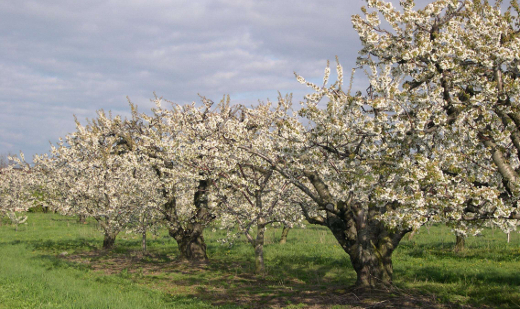
What happens when you take some of the most productive farmland in Ontario, add huge pressure to build on it, and then bring on hundreds of activists who are determined to protect the land? You get the Preservation of Agricultural Lands Society and the Christian Farmers Federation of Ontario.
The Preservation of Agricultural Lands Society (PALS) and the Christian Farmers Federation of Ontario (CFFO) — two groups that worked and fought together, to change the thinking of those who would allow the province’s farmland to be gobbled up by development.
Gracia Janes and John Bacher of PALS and Elbert van Donkersgoed of the CFFO have been part of the work to protect farmland since Ontarians first started giving the issue serious attention in the 1970s.
A Changing Landscape
Up until then, southern Ontario was changing fast from a largely rural region into the now heavily populated area known as the Greater Golden Horseshoe. It stretches from the Niagara Peninsula to the eastern edge of the Greater Toronto Area and is home to more than 5 million people.
As the population grew, so did clashes over land use. Cities and towns wanted to expand onto farmland, and some farmers were eager to sell pieces of their land for a large profit, to retire or seek other work.
The planning rules were loose. For example, at the time, Ontario’s Planning Act allowed rural landowners to “checkerboard” their properties — break it up into small patches like a checkerboard and sell off these bits for houses, gas stations or strip malls. The effects can be seen to this day in areas where there are lines of small buildings beside roads, but farmers’ fields behind. The checkerboarded areas are not quite rural, but not built up enough for people to walk to as they would in a village or city. Municipalities also took advantage of weak planning to expand urban boundaries out into the farmlands.
It seemed like this was Ontario’s future. Niagara’s fruit belt was particularly vulnerable — it’s a narrow strip of land near both the U.S. border and the heavily populated Toronto area, yet where the climate and soil makes it possible to grow superb tender fruit, such as peaches, cherries, plums and apricots as well as a variety of grapes. In the early 1950s, then-Premier Leslie Frost put it this way: "The fruit land of Niagara is doomed to vanish under industrial encroachment. We can't stop progress." By the mid- 1970s this prophecy seemed to be coming true, as Niagara was experiencing the fastest rate of sprawl in Canada.
It didn’t happen that way, thanks in large part to the work of PALS and CFFO and their members. The change from rural to urban continues today, but there are safeguards, protected areas and tougher planning rules to preserve farmland from unbridled urban sprawl.
Activism for farmlands
PALS was formed in 1976 by ardent fruit land preservationists, such as NDP MPP Mel Swart and Brock University Professor Bob Hoover, as well as Janes, Bacher and 26 other founding members. They were backed by well-known University of Waterloo fruit land expert, Ralph Krueger, the Christian Farmers and more than 500 people from both rural and urban areas who were worried about swiftly vanishing fruit lands, a third of which were gone and a third under urban shadow.
Farm members were worried about losing the land they needed to carry on their special type of farming. Rural people worried that their way of life would vanish and urbanites were concerned that there would be nothing but pavement and concrete in southern Ontario. PALS is based in Niagara, but has reached out over the years to help other farmland groups across Ontario and Canada protect prime farmlands.
The CFFO was founded by a dozen Dutch immigrants in 1954 (van Donkersgoed joined later). It is part of an international movement to share good farming practices and ethical rural values. During the 1970s and 80s, membership grew to more than 600, and the organization became more involved in public policy, including support of PALS fruit land battles , and sharing the struggle to preserve prime farmland across Ontario.
Shortly after PALS was formed, urban boundary expansions in Niagara that were proposed by municipal and regional governments led to PALS’ participation in two sets of Ontario Municipal Board (OMB) hearings from 1978 to1980. Through PALS’ intervention, the OMB ruled to protect nearly half of the 7,500 acres (3,035 hectares) of fruit land that was threatened by development.
The Ontario Municipal Board is an agency to which citizens, groups or corporations can appeal to have planning decisions reviewed and possibly overturned. Its decisions can only be overruled by the Ontario Cabinet, which happens rarely. Today, many experts argue that the OMB has too much power, or that its authority should not apply to Toronto and other big urban areas. At the same time, the OMB has been used successfully by activists to fight for environmental causes — including by PALS.
One of the most significant results of the PALS hearings was the OMB’s determination of what were supposed to be permanent boundaries for urban development in Niagara . These were first breached 20 years later, in 2001, with an OMB approval of nearly 600 acres of tender fruit land, which expanded the urban boundary of Fonthill.
A few years later, the reaction to this loss led to enormous progress being made in Niagara and in prime farmland areas across the Province, as the 2005 Greenbelt Act was enacted. It set out areas that can and cannot be developed within an area of southern Ontario the size of Prince Edward Island. While boundaries could be changed by future governments, now it would require government review and public input to change them. These boundaries aren’t set in stone, but they do designate the areas set out for fruit lands and other agriculture.
Teaching and learning
Perhaps most importantly, in addition to saving 3,400 acres of tender fruit and grape lands in Niagara by speaking up at OMB hearings, the people who fought — and still fight — to protect farmlands have done a lot to educate both the public and lawmakers. They successfully prevented a huge toxic waste site from being built in the West Lincoln area of the Niagara Peninsula, and in 1994 they persuaded the New Democratic Party government (of then-Premier Bob Rae) to bring in a Niagara Tender Fruit Land Program, under which farmers would be paid to place restrictive covenants on tender fruit lands to preserve them in perpetuity.
This Niagara Tender Fruit Land Program was cancelled almost immediately by the development-minded Progressive Conservative government of Mike Harris a year later, putting farmland again at the mercy of developers. But ironically, the Harris government later took steps to preserve land in a different area under development pressure, the Oak Ridges Moraine north of Toronto, using restrictive covenants.
Today, 85 per cent of Ontario’s tender fruit production and 80 per cent of Ontario’s grapes are grown in Niagara, and the region is an award-winning wine-producing area, thanks in large part to the people who got involved in OMB hearings, developed policy papers, organized their friends and neighbours and helped educate Ontarians about farm land.
They don’t consider their work finished. Laws and policies to protect agriculture are in place, but he Greenbelt Plan is up for review in 2015 and there are many, growing urban pressures. We must remember that once the concrete is poured on farmland, it’s not farmland anymore. That is why PALS and its supporters continue to press the government for a proven voluntary land protection program – the use of restrictive covenants to save tender fruit and grape lands for future generations of farmers and urbanites.